Osgood-Schlatter Disease
 Osgood-Schlatter Disease commonly occurs in athletic boys ranging in age from 9 to 13 years.
Osgood-Schlatter Disease commonly occurs in athletic boys ranging in age from 9 to 13 years.
Osgood-Schlatter Disease is often experienced by individuals participating in activities that require jumping, running, or stair climbing. It typically occurs in participants of soccer, football, and basketball.
The condition manifests as pain just below the knee – in the tibial tuberosity (upper part of tibia).
Click on each of the following tabs for more information about how we work with you to heal your Osgood-Schlatter Disease injury.
- Causes of Osgood-Schlatter Disease
- Traditional Treatments
- Initial Self-Treatment
- Treating with ART
- Exercise Books
- Exercise Videos
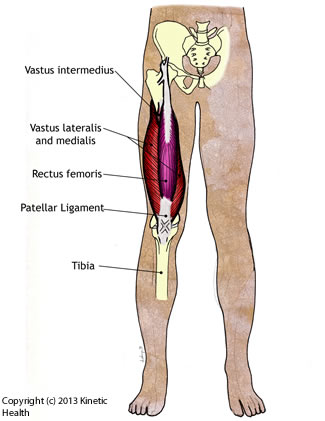 Causes of Osgood-Schlatter Disease
Causes of Osgood-Schlatter Disease
Osgood-Schlatter Disease is caused by a chronic shortening of the quadriceps (consisting of the rectus femoris, vastus lateralis, vastus medialis, and vastus intermedius).
The quadriceps connects to the patellar ligament, which runs through the knee and into the tibia.
When the quadriceps contracts during activity, the patellar ligament pulls away from the tibia, causing pain. In time, a bump may appear where the ligament is being pulled away from the bone.
Traditional Treatments for Osgood-Schlatter Disease
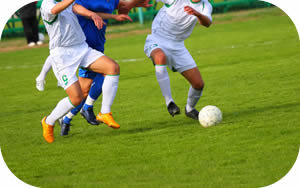 Traditional treatments typically include advice that the patient stop all physical activities – that is, stop running, stop playing baseball, stop soccer, or any other sport. In addition, both our clinic, and traditional physicians often suggest RICE (Rest, Ice, Compression, and Elevation) to be used in conjunction with stretching and strengthening exercises.
Traditional treatments typically include advice that the patient stop all physical activities – that is, stop running, stop playing baseball, stop soccer, or any other sport. In addition, both our clinic, and traditional physicians often suggest RICE (Rest, Ice, Compression, and Elevation) to be used in conjunction with stretching and strengthening exercises.
If this doesn’t work, the physician may suggest the use of some sort of support, brace, or even crutches with the idea of reducing tension on the knee tendons and quadriceps muscles.
As a last resort, surgery may be suggested. (I have never seen a case of Osgood-Schlatter Disease that required surgery to resolve the condition.)
Icing for Initial Self-Treatment
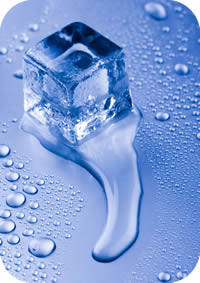 When you first feel the effects of Osgood-Schlatter, we usually recommend the RICE protocol (Rest, Ice, Compression, and Elevation). This will help to reduce the inflammation caused by the injury.
When you first feel the effects of Osgood-Schlatter, we usually recommend the RICE protocol (Rest, Ice, Compression, and Elevation). This will help to reduce the inflammation caused by the injury.
- Rest – Avoid putting additional stress on the knee.
- Ice – Apply ice to the knee for 20-30 minutes, every 2-3 hours, until the swelling is reduced.
- Compression – Apply an elastic tensor bandage your knee in conjunction with the ice, to reduce swelling.
- Elevation – Elevate your leg to help reduce inflammation. Just place a rolled up blanket or pillow under your knee.
This treatment is often combined with stretching of the quadriceps, psoas, iliacus, hip flexors and their antagonist muscles.
Treating Osgood-Schlatter Disease with ART
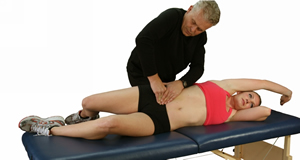 I do not believe that surgery is a good option for treating this condition. I have a lot of personal experience with this condition. I had Osgood-Schlatter as a child, and have a bump on my knee to prove it. My son, a budding rugby player, is vulnerable to this condition. And in my practice, I see many active children who also present with this condition, especially during soccer season.
I do not believe that surgery is a good option for treating this condition. I have a lot of personal experience with this condition. I had Osgood-Schlatter as a child, and have a bump on my knee to prove it. My son, a budding rugby player, is vulnerable to this condition. And in my practice, I see many active children who also present with this condition, especially during soccer season.
Osgood-Schlatter Disease is not a difficult condition to treat if you know what you are doing. At our clinic, we have successfully treated many cases of Osgood-Schlatter by using the following methodology:
- Conduct a biomechanical analysis to help identify kinetic chain restrictions.
- Use ART methodologies to identify and treat the areas that are restricted and require treatment. Typically we find restrictions in:
- Quadriceps – the secondary hip flexors.
- Iliacus and psoas – the primary hip flexors.
- Antagonistic muscles of the quadriceps, iliacus, psoas,and hip flexors.
We usually find that the child is 80 to 90% better after just two to three ART treatments. I only wish that ART had been around when I was a kid – it would have saved me a lot of pain and grief!
Books to Help you Heal
Kinetic Health provides a number of excellent resources that can help you to resolve your knee injuries.
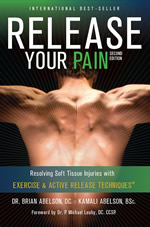 Release Your Pain: 2nd Edition
Release Your Pain: 2nd Edition
Dr.Abelson’s international best-seller – Release Your Pain – provides a detailed description about the causes, anatomy and kinetic chains of Osgood-Schlatter Diseas and other knee injuries. It discusses means for resolving this condition, and provides specially selected exercises to help you begin the process of healing from this condition.
Visit our website at www.releaseyourbody.com to purchase your eBook or hard-copy.
Exercise Videos for Osgood-Schlatter Disease
The following videos by Dr. Abelson provide extra information about injuries of the knee, as well as exercises to help resolve this condition. Click on the left and right arrows to scroll through these videos.
- PNF – Quadriceps
- Click To PlayPlay Video
PNF Stretching is a great way to release the quadriceps muscles. A common structure involved in knee pain, and lower extremity problems.
- PNF – Hamstring Stretch
- Click To PlayPlay Video
PNF Stretching is a great way to release the hamstring muscles. A common structures involved in low back pain, sciatica, knee pain, and lower extremity problems.
- Foam Roller – The Quadriceps
- Click To PlayPlay Video
The quadriceps is a group of four muscles that run along the front of your thigh. This foam roller exercise helps to release restrictions in this group of muscles.
- Foam Roller Hamstrings
For more information about our clinic in Calgary, Alberta – please visit www.kinetichealth.ca.
(COPYRIGHT KINETIC HEALTH 2013 – ALL RIGHTS RESERVED)
